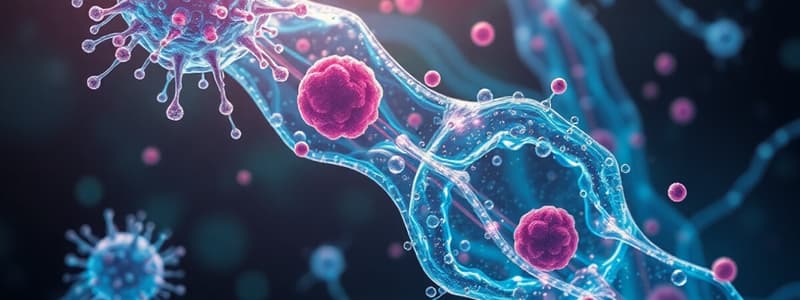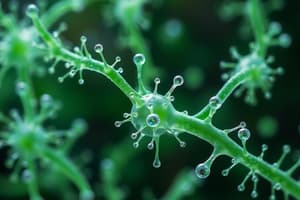Podcast
Questions and Answers
Which of the following structures is responsible for producing proteins that are then transported out of the cell?
Which of the following structures is responsible for producing proteins that are then transported out of the cell?
- Lysosomes
- Rough Endoplasmic Reticulum (correct)
- Golgi Apparatus
- Mitochondria
What is the primary function of lysosomes in a cell?
What is the primary function of lysosomes in a cell?
- Cell division
- Waste breakdown (correct)
- Energy production
- Protein synthesis
Which of these is a type of cell that is responsible for engulfing and destroying bacteria?
Which of these is a type of cell that is responsible for engulfing and destroying bacteria?
- B-cells
- Neutrophils (correct)
- T-cells
- Plasma cells
What is the primary difference between nonspecific and specific defense mechanisms in the immune system?
What is the primary difference between nonspecific and specific defense mechanisms in the immune system?
Which of the following is NOT a characteristic of inflammation?
Which of the following is NOT a characteristic of inflammation?
What is the primary function of T-cells in the immune system?
What is the primary function of T-cells in the immune system?
What is the role of memory B-cells in the immune system?
What is the role of memory B-cells in the immune system?
Which of the following is NOT a characteristic of viruses?
Which of the following is NOT a characteristic of viruses?
Which of the following statements about bacterial spores is TRUE?
Which of the following statements about bacterial spores is TRUE?
What is the role of the Golgi Apparatus in a cell?
What is the role of the Golgi Apparatus in a cell?
What is the primary role of normal flora in a healthy individual?
What is the primary role of normal flora in a healthy individual?
Which mode of transmission involves respiratory droplets traveling less than one meter?
Which mode of transmission involves respiratory droplets traveling less than one meter?
Which of the following is an example of indirect contact transmission?
Which of the following is an example of indirect contact transmission?
Which type of transmission is characterized by the movement of pathogens through arthropods?
Which type of transmission is characterized by the movement of pathogens through arthropods?
What is a characteristic of transient flora?
What is a characteristic of transient flora?
Which of the following microorganisms are considered prokaryotic and lack a true nucleus?
Which of the following microorganisms are considered prokaryotic and lack a true nucleus?
What is the primary characteristic that distinguishes viruses from all other microorganisms?
What is the primary characteristic that distinguishes viruses from all other microorganisms?
Which of the following is a correct statement regarding the life cycle of bacteria?
Which of the following is a correct statement regarding the life cycle of bacteria?
What is the primary difference between Archaea and Bacteria?
What is the primary difference between Archaea and Bacteria?
Which of the following is NOT a characteristic of eukaryotic cells?
Which of the following is NOT a characteristic of eukaryotic cells?
Which of the following organisms is known to be a plant pathogen lacking a protein coat?
Which of the following organisms is known to be a plant pathogen lacking a protein coat?
Which of the following is an example of a metabolically active form of bacteria?
Which of the following is an example of a metabolically active form of bacteria?
Which of the following is a characteristic of prions that differentiates them from viruses?
Which of the following is a characteristic of prions that differentiates them from viruses?
Flashcards
Transient Flora
Transient Flora
Microorganisms that temporarily inhabit the body, lasting hours to months.
Opportunistic Pathogens
Opportunistic Pathogens
Normal flora that cause disease when balance is disrupted.
Contact Transmission
Contact Transmission
Pathogen transfer through direct contact between hosts or via fomite.
Vector Transmission
Vector Transmission
Signup and view all the flashcards
Airborne Transmission
Airborne Transmission
Signup and view all the flashcards
Microbiology
Microbiology
Signup and view all the flashcards
Microorganisms
Microorganisms
Signup and view all the flashcards
Prokaryotes
Prokaryotes
Signup and view all the flashcards
Eukaryotes
Eukaryotes
Signup and view all the flashcards
Sporulation
Sporulation
Signup and view all the flashcards
Taxonomy
Taxonomy
Signup and view all the flashcards
Prions
Prions
Signup and view all the flashcards
Bioremediation
Bioremediation
Signup and view all the flashcards
Germination
Germination
Signup and view all the flashcards
Mitochondria
Mitochondria
Signup and view all the flashcards
Ribosomes
Ribosomes
Signup and view all the flashcards
Endoplasmic Reticulum (ER)
Endoplasmic Reticulum (ER)
Signup and view all the flashcards
Golgi Apparatus
Golgi Apparatus
Signup and view all the flashcards
Lysosomes
Lysosomes
Signup and view all the flashcards
Phagocytosis
Phagocytosis
Signup and view all the flashcards
Inflammation
Inflammation
Signup and view all the flashcards
Cell-mediated Immunity
Cell-mediated Immunity
Signup and view all the flashcards
Antibody-mediated Immunity
Antibody-mediated Immunity
Signup and view all the flashcards
Study Notes
Microbiology
- Study of organisms too small to see without magnification
- Originated with the invention of the microscope
- Microorganisms include bacteria, viruses, fungi, protozoa, helminths (worms), algae, prions
Branches of Study
- Immunology
- Public health microbiology and epidemiology
- Food, dairy, and aquatic microbiology
- Biotechnology
- Genetic engineering and recombinant DNA technology
- Manipulating genes
Microbes' Roles
- Nutrient production and energy flow
- Decomposition
- Biotechnology (food, drugs, vaccines)
- Genetic engineering
- Bioremediation
- Infectious disease
Classification of Microorganisms (Protists)
Cellular
- Prokaryotes: Lack a true nucleus (pro=before, karyon=nucleus)
- Archaea, bacteria, blue-green algae
- Eukaryotes: With a true nucleus
- Algae (excluding blue-green), fungi, protozoans
Non-Cellular
- Viruses, viroids, prions
Taxonomy
-
Formal system for organizing, classifying, and naming living organisms
-
Bacteria: Prokaryotic, unicellular organisms
-
Archaea: Prokaryotic, unicellular organisms living in extreme environments
-
Algae: Eukaryotic organisms, unicellular or multicellular
-
Fungi: Eukaryotic organisms, unicellular or multicellular
-
Protozoa: Eukaryotic, unicellular or multicellular organisms
-
Viruses: Noncellular, seen only with electron microscopy; consist of NA surrounded by a protein coat
Bacterial Life Cycle
- Vegetative Form: Metabolically active, growing, multiplying; causes infection
- Spore Form: Inert, resting, non-growing; highly resistant
Cytoplasmic Organelles
- Mitochondria: Power site, contains ATP
- Ribosomes: Synthesize proteins
- Endoplasmic Reticulum: Involved in lipid and protein synthesis
- Golgi Apparatus: Packaging center
- Lysosomes: Contain digestive enzymes
- Centrioles: Involved in cell division
- Cilia: Short, hair-like structures for movement
- Flagella: Long, whip-like structures for movement
- Chloroplasts: Convert sunlight to chemical energy (photosynthesis)
Defense Mechanisms
- Nonspecific: Act against all harmful agents; provides resistance
- Specific: Act against certain agents; provides immunity; lacking resistance is called susceptibility
- Virulence: degree of pathogenicity or disease-provoking power of a microbe
Modes of Transmission
- Contact: Direct (physical touch), Indirect (via fomites)
- Droplet: Respiratory droplets (<1 meter)
- Airborne: Respiratory droplets (>1 meter)
- Water-borne/Food-borne: Contaminated water/food
- Vector-borne: Animals carrying pathogens
Applied Microbiology
- Food production (yogurt, bread, wine, beer)
- Water treatment
- Pharmaceutical agents (penicillin)
- Bioremediation
- Forensics (medicine, crime)
- Energy (ethanol, methane)
Studying That Suits You
Use AI to generate personalized quizzes and flashcards to suit your learning preferences.



